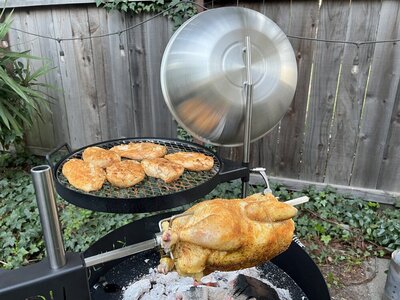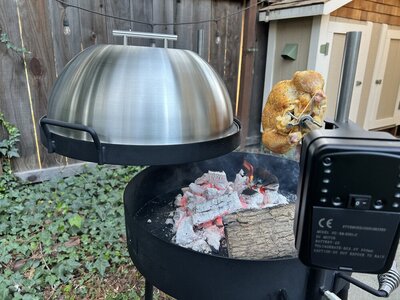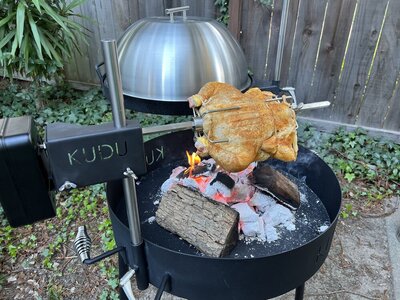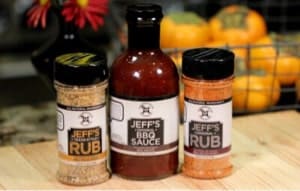- Apr 13, 2022
- 1
- 6
Hi, everyone.
I'm a middle aged dude from Cape Town, South Africa who's slowly been getting into the bbq/meat smoking thing and I'm hoping to learn a few things here.
Stuff that may be relevant:
Born and raised in suburban Cape Town, SA (South Africa). We have a huge meat eating culture. We actually have a national holiday called National Braai Day (aka Heritage Day). It's not unusual for families to braai at least once a week but often more, usually for dinner.
A Braai is a South African BBQ - it's an open fire bbq that uses wood as a fuel source to create a bed of coals over which meat is cooked on a steel grid. Many apartment dwellers and people with a more English heritage might resort to using kettle braais like Webers with charcoal briquettes, we don't associate with those folks. "Braai" is both a noun and a verb, yes.
As for smoking meats, that's still a relatively new thing here. We do have a handful of restaurants around the greater Cape Town area that serve a selection of smoked meats and everyone who goes there LOVES the food. But uptake is slow in the home-smoker market due to the barrier to entry being pretty high in terms of initial costs (this is a poor country) as well as the time investment that smoking meat can often require. Basically, if you own a smoker or especially a Kamado (import) type smoker you're either very enthusiastic about smoking meat or have a lot of spending money so, also probably middle aged or retired.
I moved into a new house 3 years ago and there was no braai (many, many houses have built-in braais in a "braai room" (patio-ish area)) and I didn't possess a decent mobile braai (essentially a large metal tray on wheels with some fittings to hold a grid). So I said F-it and bought a Kamado Joe as I'd been eyeing one for quite some time. We have our own version of Kamado Joe called Kamado Jan, looks the same, same fittings and layout.
This got me into the world of smoking meats.
I've done a few briskets, with about a 50% success rate. Lots of pork belly-ribs. Pork belly burnt ends. A few chickens. And even a springbok (a type of buck) leg for xmas one time.
I don't have a proper offset or cabinet smoker (yet). The effort that I've seen go into cooking with those scares me. I do have a few friends that have those and I've been keeping an eye on what's involved when cooking on those.
Looking forward to learning from the OG smokers on this forum.
Cheers
An aside on meat in SA for those who are interested - we're big on beef, but our beef is nothing like US feedlot cattle. We don't have facilities like those and most of our beef would probably qualify as "free-range" in the States. Hence our biggest briskets are about half the size of the ones I see on youtube smoking vids. Wagyu is only recently available here, some local farmers have imported a line of wagyu cows and recently I got my hands on my first two wagyu briskets which I'm REALLY excited about. Our usual briskets are a lot leaner that what seems to be available in the States so it's a real challenge not drying them out. So much so that I've started cooking the flat and the tip separately, otherwise the tip is juicy and the flat is dry.
In terms of what is normally cooked on a braai over here:
Beef - steak(s) and wors (traditional type of sausage made with sheep gut for casing and traditionally lots of coriander seeds)
Pork - chops, spare ribs (marinated), sausages (bangers), sausages with extra fillings like cheese, smoked pork meats (like bacon) twirled around kebab sticks and marinated
Chicken - pieces and spatchcock, usually heavily marinated
Lamb - chops, chops, and more chops, and some ribs. The legs are usually reserved for the oven and the neck, bones etc for "potjie" (another traditional stew type thing).
Kebabs or Espetadas - all of the above meats cut into chunks and stuck on a wooden stick with some vegetables (bell peppers, onions, etc) in between. Usually heavily marinated.
A final word on South African lamb. We have a unique form of lamb here called "Karoo" lamb, named for the Karoo region it comes from - a semi arid region with a unique type of flora. Karoo lamb ideally grows up eating the indigenous plants almost exclusively and as a result the meat has a very unique, tasty flavour because they've basically been spiced their whole life. Compared to Karoo lamb normal lamb or mutton tastes like sheep smell, if you ask me.
I'm a middle aged dude from Cape Town, South Africa who's slowly been getting into the bbq/meat smoking thing and I'm hoping to learn a few things here.
Stuff that may be relevant:
Born and raised in suburban Cape Town, SA (South Africa). We have a huge meat eating culture. We actually have a national holiday called National Braai Day (aka Heritage Day). It's not unusual for families to braai at least once a week but often more, usually for dinner.
A Braai is a South African BBQ - it's an open fire bbq that uses wood as a fuel source to create a bed of coals over which meat is cooked on a steel grid. Many apartment dwellers and people with a more English heritage might resort to using kettle braais like Webers with charcoal briquettes, we don't associate with those folks. "Braai" is both a noun and a verb, yes.
As for smoking meats, that's still a relatively new thing here. We do have a handful of restaurants around the greater Cape Town area that serve a selection of smoked meats and everyone who goes there LOVES the food. But uptake is slow in the home-smoker market due to the barrier to entry being pretty high in terms of initial costs (this is a poor country) as well as the time investment that smoking meat can often require. Basically, if you own a smoker or especially a Kamado (import) type smoker you're either very enthusiastic about smoking meat or have a lot of spending money so, also probably middle aged or retired.
I moved into a new house 3 years ago and there was no braai (many, many houses have built-in braais in a "braai room" (patio-ish area)) and I didn't possess a decent mobile braai (essentially a large metal tray on wheels with some fittings to hold a grid). So I said F-it and bought a Kamado Joe as I'd been eyeing one for quite some time. We have our own version of Kamado Joe called Kamado Jan, looks the same, same fittings and layout.
This got me into the world of smoking meats.
I've done a few briskets, with about a 50% success rate. Lots of pork belly-ribs. Pork belly burnt ends. A few chickens. And even a springbok (a type of buck) leg for xmas one time.
I don't have a proper offset or cabinet smoker (yet). The effort that I've seen go into cooking with those scares me. I do have a few friends that have those and I've been keeping an eye on what's involved when cooking on those.
Looking forward to learning from the OG smokers on this forum.
Cheers
An aside on meat in SA for those who are interested - we're big on beef, but our beef is nothing like US feedlot cattle. We don't have facilities like those and most of our beef would probably qualify as "free-range" in the States. Hence our biggest briskets are about half the size of the ones I see on youtube smoking vids. Wagyu is only recently available here, some local farmers have imported a line of wagyu cows and recently I got my hands on my first two wagyu briskets which I'm REALLY excited about. Our usual briskets are a lot leaner that what seems to be available in the States so it's a real challenge not drying them out. So much so that I've started cooking the flat and the tip separately, otherwise the tip is juicy and the flat is dry.
In terms of what is normally cooked on a braai over here:
Beef - steak(s) and wors (traditional type of sausage made with sheep gut for casing and traditionally lots of coriander seeds)
Pork - chops, spare ribs (marinated), sausages (bangers), sausages with extra fillings like cheese, smoked pork meats (like bacon) twirled around kebab sticks and marinated
Chicken - pieces and spatchcock, usually heavily marinated
Lamb - chops, chops, and more chops, and some ribs. The legs are usually reserved for the oven and the neck, bones etc for "potjie" (another traditional stew type thing).
Kebabs or Espetadas - all of the above meats cut into chunks and stuck on a wooden stick with some vegetables (bell peppers, onions, etc) in between. Usually heavily marinated.
A final word on South African lamb. We have a unique form of lamb here called "Karoo" lamb, named for the Karoo region it comes from - a semi arid region with a unique type of flora. Karoo lamb ideally grows up eating the indigenous plants almost exclusively and as a result the meat has a very unique, tasty flavour because they've basically been spiced their whole life. Compared to Karoo lamb normal lamb or mutton tastes like sheep smell, if you ask me.







